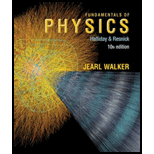
Concept explainers
To calculate:
(a) the number of sub-shells for n = 2
(b) the electron states n = 2
(c) the number of sub-shells for n = 5
(d) the electron states n = 5
Answer to Problem 1Q
Solution:
(a) For n = 2, it has 2 sub shells.
(b) For n = 2, there will be 8 electron states.
(c) For n = 5, it has 5 sub shells.
(d) For n = 5, there will be 50 electron states
Explanation of Solution
For a given quantum number n there are n possible values of l, ranging from 0 to n −1.
For each l the number of possible electron states with ml values is (2l + 1).
For each ml the electron can have two different spin orientations.
Thus, the total number of electron states for a given l is given by Nl = 2(2 l+ 1).
(e) For n = 2, it has 2 sub shells.
(f) For n = 2, the number of electrons 2n2, there will be 8 electron states.
(g) For n = 5, it has 5 sub shells.
(h) For n = 5, the number of electrons 2n2, there will be 50 electron states
Conclusion
For an l quantum number, there are (2l+1) number of possible ml values.
Want to see more full solutions like this?
Chapter 40 Solutions
Fundamentals of Physics
- Don't use ai to answer I will report you answerarrow_forwardwhy did the expert subtract the force exerted by the hand and the elbow by the force due to the weight of the hand and forearm and force exerted by the tricep. Does the order matter and how do you determine what to put first. Question 4 AP, CHAPTER 13 FROM BASIC BIOMECHANICS 8TH EDITIONarrow_forwardThe drawing illustrates the dispersion of light by a prism. The prism is made from a certain type of glass, and has a cross section shaped like an equilateral triangle. The indices of refraction for the red and violet light in this type of glass are 1.649 and 1.694, respectively. The angle of incidence for both the red and violet light is 60.0°. Find the angles of refraction at which the (a) red and (b) violet rays emerge into the air from the prism. Glass prism Incident light Normal (a) Normal Incident light Red (660 nm) (b) Violet (410 nm)arrow_forward
- Don't use ai to answer I will report you answerarrow_forwardA glass block (n = 1.56) is immersed in a liquid. A ray of light within the glass hits a glass- liquid surface at a 70.0° angle of incidence. Some of the light enters the liquid. What is the smallest possible refractive index for the liquid?arrow_forwardThe drawing shows a crystalline slab (refractive index 1.995) with a rectangular cross section. A ray of light strikes the slab at an incident angle of 01 = 35.0°, enters the slab, and travels to point P. This slab is surrounded by a fluid with a refractive index n. What is the maximum value of n such that total internal reflection occurs at point P? Ме Buarrow_forward
- What is the amount of M112 needed to breach a 5-foot thick dense concrete wall utilizing an internal charge placed in the center of the target?arrow_forwardA small postage stamp is placed in front of a concave mirror (radius = 1.1 m), such that the image distance equals the object distance. (a) What is the object distance? (b) What is the magnification of the mirror (with the proper sign)?arrow_forwardCalculate the anti-clockwise torque and the clockwise torque of the system with the ruler and the washers. Record these values in Data Table 5. Ruler = 11.56 g, small washer = 1.85 g, large washer = 24.30 g. Calculate the % Difference in the Torques and record the values in Data Table 5. Is ΣAnticlockwise torque and Anticlockwise torque the same thing, are they solved in the same way?arrow_forward
- A window washer stands on a uniform plank of mass M = 142 kg and length l = 2.80 m supported by 2 ropes attached at the ends of the plank. The window washer has a mass m = 68.0 kg. What is the tension in each of the ropes, T1 and T2, if the window washer's displacement from the center of mass of the plank is x = 0.930 m as shown in Figure 1: Window Washer Problem?arrow_forwardA man holds a double-sided spherical mirror so that he is looking directly into its convex surface, 33 cm from his face. The magnification of the image of his face is +0.17. What will be the image distance when he reverses the mirror (looking into its concave surface), maintaining the same distance between the mirror and his face? Be sure to include the algebraic sign (+ or -) with your answer.arrow_forwardHow do you draw a diagram of the ruler and mass system in equilibrium identifying the anti-clockwise torque and clockwise torque? How do I calculate the anti-clockwise torque and the clockwise torque of the system with the ruler and the washers, does it come from the data in table 4? Please help, thank you!arrow_forward
 Modern PhysicsPhysicsISBN:9781111794378Author:Raymond A. Serway, Clement J. Moses, Curt A. MoyerPublisher:Cengage Learning
Modern PhysicsPhysicsISBN:9781111794378Author:Raymond A. Serway, Clement J. Moses, Curt A. MoyerPublisher:Cengage Learning Glencoe Physics: Principles and Problems, Student...PhysicsISBN:9780078807213Author:Paul W. ZitzewitzPublisher:Glencoe/McGraw-Hill
Glencoe Physics: Principles and Problems, Student...PhysicsISBN:9780078807213Author:Paul W. ZitzewitzPublisher:Glencoe/McGraw-Hill Principles of Physics: A Calculus-Based TextPhysicsISBN:9781133104261Author:Raymond A. Serway, John W. JewettPublisher:Cengage Learning
Principles of Physics: A Calculus-Based TextPhysicsISBN:9781133104261Author:Raymond A. Serway, John W. JewettPublisher:Cengage Learning University Physics Volume 3PhysicsISBN:9781938168185Author:William Moebs, Jeff SannyPublisher:OpenStax
University Physics Volume 3PhysicsISBN:9781938168185Author:William Moebs, Jeff SannyPublisher:OpenStax College PhysicsPhysicsISBN:9781305952300Author:Raymond A. Serway, Chris VuillePublisher:Cengage Learning
College PhysicsPhysicsISBN:9781305952300Author:Raymond A. Serway, Chris VuillePublisher:Cengage Learning College PhysicsPhysicsISBN:9781285737027Author:Raymond A. Serway, Chris VuillePublisher:Cengage Learning
College PhysicsPhysicsISBN:9781285737027Author:Raymond A. Serway, Chris VuillePublisher:Cengage Learning





